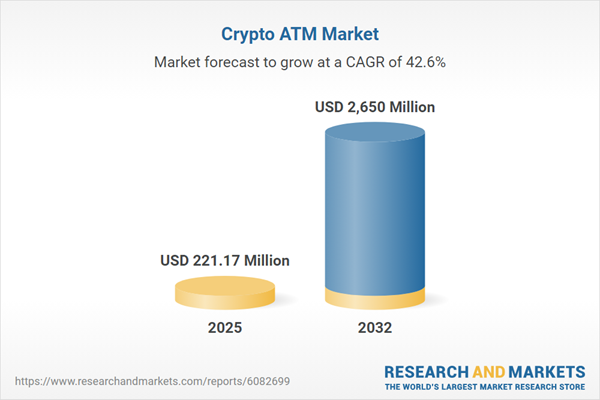Speak directly to the analyst to clarify any post sales queries you may have.
The cryptocurrency ATM market stands at a pivotal juncture, shaped by rapid technology upgrades, policy evolution, and the mainstream adoption of digital assets. Senior decision-makers must navigate complex regulatory landscapes while leveraging innovation for operational resilience and strategic growth.
Market Snapshot: Cryptocurrency ATM Market Overview
The global cryptocurrency ATM market is witnessing robust expansion, progressing from USD 155.49 million in 2024 to USD 221.17 million in 2025 and projected to reach USD 2.65 billion by 2032 at a compound annual growth rate of 42.55%. This strong trajectory is driven by persistent enterprise investment, evolving consumer usage patterns, and the demand for streamlined onboarding channels to digital assets. As a result, the sector attracts interest from financial institutions, fintech firms, and banking networks prioritizing scalable and adaptable ATM infrastructure for digital asset transactions.
Scope & Segmentation
This report delivers actionable segmentation, giving leaders a clear view of the fast-progressing cryptocurrency ATM ecosystem and identifying critical operational, technical, and regulatory touchpoints.
- Cryptocurrency Type: Analysis covers Bitcoin, Ethereum, and Litecoin, offering insights into key digital assets enabled via ATMs.
- Machine Type: Examination includes both freestanding and wall-mounted units, underlining deployment flexibility across retail, commercial, and institutional settings.
- End User: Reporting encompasses commercial, institutional, and retail clients to highlight unique user requirements and operational flows.
- Service Type: Assessment addresses functionalities such as bill payments, asset exchange, and account top-up, reflecting service differentiation and various engagement models.
- Key Regions: Geographic scope spans the Americas (with coverage of North America and Latin America), Europe, Middle East & Africa (emphasizing the UK, Germany, UAE, Saudi Arabia, and South Africa), and Asia-Pacific (highlighting China, India, Japan, Australia, among others).
- Market Players: Evaluation features operators including Bitcoin Depot, Coinsource, CoinFlip, General Bytes, Genesis Coin, CoinCloud, Lamassu, BitAccess, RockItCoin, and Coinme, with analysis on market positioning and competitive strategy.
- Technology Focus: The study considers topics such as ATM security, user interface optimization, real-time monitoring systems, and digital wallet integration, with parallel attention to compliance, anti-money laundering protocols, and sector transparency.
This comprehensive segmentation assists organizations in identifying business prospects, adapting to jurisdictional demands, and building resilient strategies for stakeholder engagement.
Key Takeaways for Senior Decision-Makers
- Biometric authentication and modular ATM hardware are advancing product differentiation, driving improvements in transaction security and process efficiency.
- Operators employ agile compliance approaches, optimize partner relationships, and upgrade technical systems to proactively navigate volatile regulatory conditions.
- Supply chain strategies now emphasize diversity and nearshoring, reducing reliance on single sources and mitigating geopolitical risks for uninterrupted operations.
- Expansion and deployment now benefit from data-driven analysis of location traffic, enhanced user segmentation, and region-specific purchasing trends to fine-tune market entry approaches.
- Providers enhance market engagement by offering tailored solutions, such as institutional-grade reporting tools and simplified retail interfaces, supporting broader adoption across segments.
- Long-term regional success depends on proactive policy dialogue and adaptive, localized strategies responsive to shifting compliance requirements and customer expectations.
Tariff Impact on Cryptocurrency ATM Operations
The implementation of new tariffs in the United States in 2025 has increased operational complexity, influencing component sourcing and manufacturing costs for cryptocurrency ATM operators. In response, industry participants are realigning supplier networks, adopting nearshoring, and revising procurement frameworks to manage exposure to market fluctuations. These measures lead to evolving pricing tactics and continual assessment of profitability, with a consistent emphasis on maintaining deployment pace and service reliability.
Methodology & Data Sources
This report employs structured interviews with industry leaders, compliance experts, and technical specialists. Data is further substantiated by analysis of sector whitepapers, official regulatory submissions, secondary data sources, and scholarly publications, ensuring robust coverage of technology, operations, and risk management themes.
Why This Report Matters: Actionable Insights for Leadership
- Presents deep segmentation and operational evaluation to guide strategic investment and informed deployment initiatives.
- Supports the adoption of flexible technology and compliance strategies, with adaptation to meet regional and client needs.
- Enables early identification of market risks, growth opportunities, and partnerships critical for success in the cryptocurrency ATM sector.
Conclusion
This analysis delivers practical guidance for leadership teams, supporting confident decision-making and sustainable business growth in the fast-evolving cryptocurrency ATM landscape.
Table of Contents
3. Executive Summary
4. Market Overview
7. Cumulative Impact of Artificial Intelligence 2025
List of Figures
Companies Mentioned
The companies profiled in this Crypto ATM market report include:- Bitcoin Depot, LLC
- Coinsource, Inc.
- CoinFlip, Inc.
- General Bytes s.r.o.
- Genesis Coin, Inc.
- CoinCloud, LLC
- Lamassu Inc.
- BitAccess Inc.
- RockItCoin, Inc.
- Coinme, Inc.
Table Information
| Report Attribute | Details |
|---|---|
| No. of Pages | 190 |
| Published | November 2025 |
| Forecast Period | 2025 - 2032 |
| Estimated Market Value ( USD | $ 221.17 Million |
| Forecasted Market Value ( USD | $ 2650 Million |
| Compound Annual Growth Rate | 42.5% |
| Regions Covered | Global |
| No. of Companies Mentioned | 11 |









